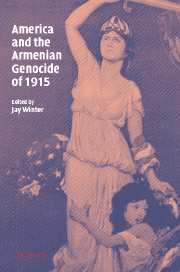Book contents
- Frontmatter
- Contents
- List of contributors
- Map
- Acknowledgments
- Introduction: witness to genocide
- Part 1 The framework
- Part II During the Catastrophe
- 4 A friend in power? Woodrow Wilson and Armenia
- 5 Wilsonian diplomacy and Armenia: the limits of power and ideology
- 6 American diplomatic correspondence in the age of mass murder: the Armenian Genocide in the US archives
- 7 The Armenian Genocide and American missionary relief efforts
- 8 Mary Louise Graffam: witness to genocide
- 9 From Ezra Pound to Theodore Roosevelt: American intellectual and cultural responses to the Armenian Genocide
- Part III After the Catastrophe
- Index
- Studies in the Social and Cultural History of Modern Warfare
4 - A friend in power? Woodrow Wilson and Armenia
Published online by Cambridge University Press: 04 September 2009
- Frontmatter
- Contents
- List of contributors
- Map
- Acknowledgments
- Introduction: witness to genocide
- Part 1 The framework
- Part II During the Catastrophe
- 4 A friend in power? Woodrow Wilson and Armenia
- 5 Wilsonian diplomacy and Armenia: the limits of power and ideology
- 6 American diplomatic correspondence in the age of mass murder: the Armenian Genocide in the US archives
- 7 The Armenian Genocide and American missionary relief efforts
- 8 Mary Louise Graffam: witness to genocide
- 9 From Ezra Pound to Theodore Roosevelt: American intellectual and cultural responses to the Armenian Genocide
- Part III After the Catastrophe
- Index
- Studies in the Social and Cultural History of Modern Warfare
Summary
Two facts overshadow everything else about Woodrow Wilson's relationship with the Armenian Genocide. First, he was President of the United States when those atrocities occurred. Second, he did not intervene to try to stop those atrocities. Wilson's situation vis á vis the Armenian Genocide eerily foreshadowed Franklin Roosevelt's towards the Holocaust a generation later. The same question arises about both leaders – why? Why did they act or fail to act as they did? Likewise, with both leaders that question has a necessary antecedent. This is Senator Howard Baker's famous, repeated query to the witnesses at the Watergate committee hearings in 1973: “What did the president know, and when did he know it?” That is the first question that needs to be put to President Wilson about Armenia.
As is rarely the case with historical evidence, it is possible to give a precise, even quantitative estimate of what Wilson knew about Armenia and when he knew it. Thanks to Arthur Link's monumental edition of The Papers of Woodrow Wilson (hereafter Wilson Papers), it is possible to measure, at least roughly, the attention that Wilson gave to Armenia. The measurements come from the three cumulative index volumes of the Wilson Papers that cover the years between his becoming President in 1913 and his death in 1924.
The first of these indexes is for the twelve volumes that cover 1913 through 1916. Under “Armenia” there are three entries; more important, under “Armenians, plight of” there are six entries.
- Type
- Chapter
- Information
- America and the Armenian Genocide of 1915 , pp. 103 - 112Publisher: Cambridge University PressPrint publication year: 2004
- 1
- Cited by

